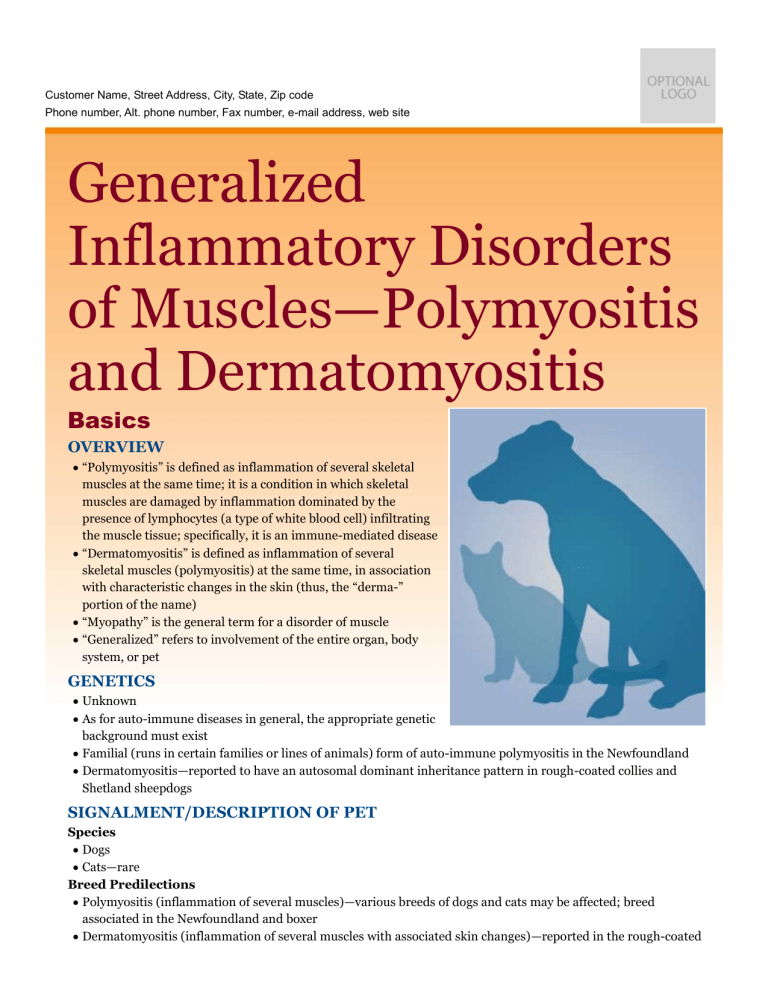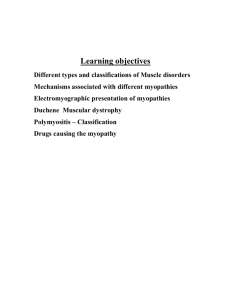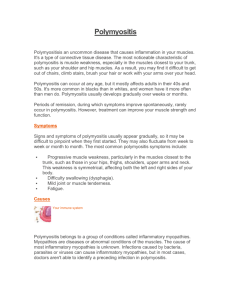generalized_inflammatory_disorders_of_muscles

Customer Name, Street Address, City, State, Zip code
Phone number, Alt. phone number, Fax number, e-mail address, web site
Generalized
Inflammatory Disorders of Muscles—Polymyositis and Dermatomyositis
Basics
OVERVIEW
• “Polymyositis” is defined as inflammation of several skeletal muscles at the same time; it is a condition in which skeletal muscles are damaged by inflammation dominated by the presence of lymphocytes (a type of white blood cell) infiltrating the muscle tissue; specifically, it is an immune-mediated disease
• “Dermatomyositis” is defined as inflammation of several skeletal muscles (polymyositis) at the same time, in association with characteristic changes in the skin (thus, the “derma-” portion of the name)
• “Myopathy” is the general term for a disorder of muscle
• “Generalized” refers to involvement of the entire organ, body system, or pet
GENETICS
• Unknown
• As for auto-immune diseases in general, the appropriate genetic background must exist
• Familial (runs in certain families or lines of animals) form of auto-immune polymyositis in the Newfoundland
• Dermatomyositis—reported to have an autosomal dominant inheritance pattern in rough-coated collies and
Shetland sheepdogs
SIGNALMENT/DESCRIPTION OF PET
Species
• Dogs
• Cats—rare
Breed Predilections
• Polymyositis (inflammation of several muscles)—various breeds of dogs and cats may be affected; breed associated in the Newfoundland and boxer
• Dermatomyositis (inflammation of several muscles with associated skin changes)—reported in the rough-coated
collie, Shetland sheepdog, and Australian cattle dog
Mean Age and Range
• Polymyositis (inflammation of several muscles)—none obvious
• Dermatomyositis (inflammation of several muscles with associated skin changes)—3–5 months of age
SIGNS/OBSERVED CHANGES IN THE PET
• Polymyositis (inflammation of several muscles)—usually associated with a stiff-stilted gait, variable muscle pain, and/or muscle weakness; may see regurgitation (return of food or other contents from the esophagus or stomach back up through the mouth) and megaesophagus (enlarged esophagus)
• Elevated serum creatine kinase (a muscle enzyme) levels—supports, but does not make, the diagnosis of inflammation of the muscles (known as “myositis”)—do not rule out polymyositis if creatine kinase is normal
• Stiff-stilted gait—sudden (acute) or long-term (chronic)
• Muscle swelling and/or loss of muscle mass (known as “muscle atrophy”)
• Variable muscle pain
• Generalized muscle weakness and exercise intolerance
• Regurgitation (return of food or other contents from the esophagus or stomach back up through the mouth) or difficulty swallowing
• Generalized loss of muscle mass (muscle atrophy), including the muscles of chewing (mastication)
• Nervous system examination—not abnormal; may be a decreased gag reflex if muscles of the throat (known as the “pharynx”) are affected
• Dermatomyositis (inflammation of several muscles with associated skin changes) in dogs—skin lesions
CAUSES
• Immune-mediated disease
• Infectious disease—Toxoplasma gondii; Neospora canis; tick-related diseases; bacterial infection uncommon
• Drug-induced disease
• Secondary or related to cancer (known as “paraneoplastic” or “preneoplastic” syndrome)
RISK FACTOR
• Appropriate genetic background
• Possibly previous bacterial or viral infection
• Tumor or cancer, possibly “occult”; occult is defined as “hidden”—it indicates that the primary tumor may not be identified
• Exposure to ticks
Treatment
HEALTH CARE
• Usually outpatient
• Supportive care—may be required to prevent skin wounds and decubital ulcers (“bed sores”) in non-ambulatory, severely affected pets: “non-ambulatory” means unable to walk
ACTIVITY
• Should increase, along with muscle strength, as muscle inflammation decreases
DIET
• Megaesophagus (enlarged esophagus)—may require feeding from an elevated food bowl; elevate food and water bowls; try foods of different consistencies
• Severe regurgitation (return of food or other contents from the esophagus or stomach back up through the mouth)—may need to place a feeding tube to maintain hydration and nutrition
SURGERY
• Muscle biopsy—needed to confirm the diagnosis
• If a tumor or cancer is the underlying cause of the muscle inflammation
• To place a feeding tube, in order to maintain hydration and nutrition
Medications
Medications presented in this section are intended to provide general information about possible treatment. The treatment for a particular condition may evolve as medical advances are made; therefore, the medications should not be considered as all inclusive
• Steroids—administered at levels to decrease the response of the immune system (known as “immunosuppressive dosages”); usually result in clinical improvement of immune-mediated condition; decrease to the lowest alternate-day dosage that maintains normal creatine kinase (a muscle enzyme) and improved muscle strength and mobility; may require long-term therapy
• Identified infectious agent—initiate specific therapy for the infectious agent
• Identified heart muscle failure (known as “myocardial failure”)— initiate therapy for heart failure
• If side effects of steroids are not tolerated by the owner—institute a lower dose of steroids and combine with another drug (such as azathioprine, a chemotherapeutic drug used to decrease the immune response)
Follow-Up Care
PATIENT MONITORING
• Serum creatine kinase (a muscle enzyme) levels—periodic evaluation; if elevated, should decrease into the normal range
• Steroids—side effects
POSSIBLE COMPLICATIONS
• Steroids—undesirable side effects (such as increased urination)
• Recurrence of clinical signs—treatment stopped too early
• Poor clinical response—inadequate dosages of steroids
EXPECTED COURSE AND PROGNOSIS
• Immune-mediated condition—good to fair prognosis
• Disorder secondary or related to cancer (paraneoplastic disorder) associated with occult (hidden) tumor or cancer—guarded prognosis
Key Points
• Long-term immunosuppressive therapy (medications to decrease the immune response) may be required for an immune-mediated condition
• Residual loss of muscle mass (muscle atrophy) and contracted muscles may occur with long-term (chronic) disease and extensive scarring (known as “fibrosis”)
• Suggest genetic counseling for familial (runs in certain families or lines of animals) disorders
Enter notes here
Blackwell's Five-Minute Veterinary Consult: Canine and Feline, Fifth Edition, Larry P. Tilley an d Francis W.K. Smith, Jr. © 2011 John Wiley & Sons,
Inc.









